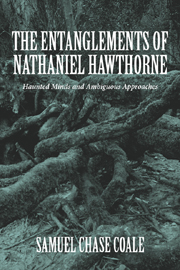Book contents
- Frontmatter
- Contents
- Acknowledgments
- List of Abbreviations
- Introduction: Entanglements
- 1 The Legacy of The Scarlet Letter: Hawthorne in Contemporary Culture
- 2 Hawthorne as Nineteenth-Century Morbid Genius
- 3 Biographical and Critical Veils in the Nineteenth Century
- 4 Biographical Visions of the Twentieth Century
- 5 Entangled Polarities: The New Criticism
- 6 Doubting Dualisms: The Strategies of Hawthorne's Romance
- 7 Ideological Contexts: Deconstruction, Feminism, the New Historicism, Race, and Entanglement
- Works Cited
- Index
Introduction: Entanglements
Published online by Cambridge University Press: 12 September 2012
- Frontmatter
- Contents
- Acknowledgments
- List of Abbreviations
- Introduction: Entanglements
- 1 The Legacy of The Scarlet Letter: Hawthorne in Contemporary Culture
- 2 Hawthorne as Nineteenth-Century Morbid Genius
- 3 Biographical and Critical Veils in the Nineteenth Century
- 4 Biographical Visions of the Twentieth Century
- 5 Entangled Polarities: The New Criticism
- 6 Doubting Dualisms: The Strategies of Hawthorne's Romance
- 7 Ideological Contexts: Deconstruction, Feminism, the New Historicism, Race, and Entanglement
- Works Cited
- Index
Summary
When the opportunity arose to write about Hawthorne once again, how could I refuse? I had critically wrestled with his work in In Hawthorne's Shadow: American Romance from Melville to Mailer (1985) and Mesmerism and Hawthorne: Mediums of American Romance (1998). While the first book traces the thematic influences and images of Hawthorne's Manichean vision on the many writers who came after him, and the second explores the effects of mesmerism on his fiction, not just thematically but structurally in terms of how he described the American romance, in this book I have produced a critical overview of critics who have written about Hawthorne and his work from as far back as the 1830s up to 2010.
This new book is meant to be a survey of Hawthorne's critics, an introduction to their work, which offers many perspectives, and will explore their strengths and weaknesses, providing an overall view of the development of Hawthorne criticism over the span of more than a hundred and fifty years. The book, therefore, attempts not to produce some new perspective on Hawthorne's fiction, although I will suggest a new way of regarding it, but to investigate and scrutinize the field of Hawthorne studies from the mid-nineteenth-century up to the present day. Its organization depends both on chronological and topical points of view, with individual chapters that deal with nineteenth-century, twentieth-century and early-twenty-first century biographies and criticism as well as the developing critical assumptions that underlie them.
- Type
- Chapter
- Information
- The Entanglements of Nathaniel HawthorneHaunted Minds and Ambiguous Approaches, pp. 1 - 4Publisher: Boydell & BrewerPrint publication year: 2011

